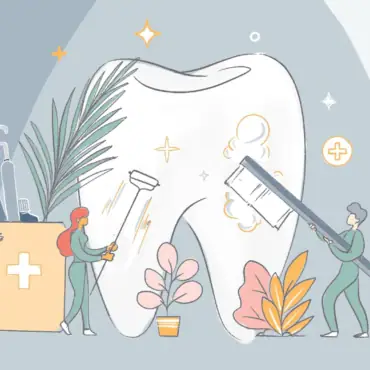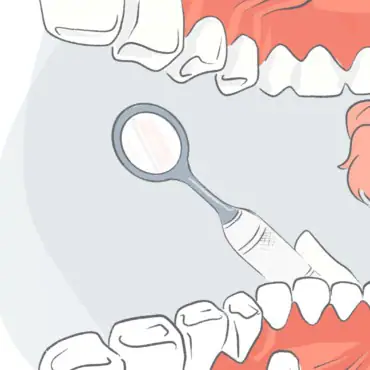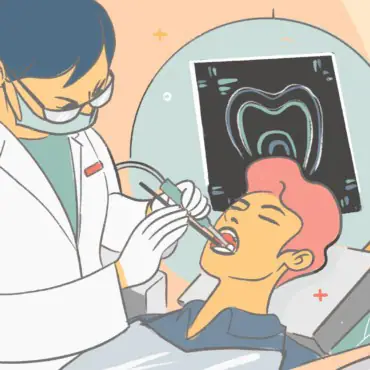Dental veneers are wafer-thin, custom-made tooth-colored shells intended to cover the front surface of teeth to enhance their appearance. These shells are attached to the front of individual teeth, altering their color, form, or size.
Dental veneer types:
Generally, dental veneers are made of porcelain or composite resin. Porcelain veneers are more resistant to stains than resin veneers. They also better imitate the light-reflecting properties of natural teeth.
What kind of issues are solved by dental veneers?
Veneers are regularly used to treat the following issues:
- Teeth that are discolored due to food, drink, or smoke staining
- Treatment of root canal
- Tooth stains caused by tetracycline or fluorosis
- Large filling of resins
- Teeth that have been worn down
- Teeth that have been chipped or lost
The cost of dental veneers
Insurers do not cover veneers since they are considered a cosmetic procedure. According to the Consumer Dentistry Guide, conventional veneers can cost an average of $925 to $2,500 per tooth, and they can last about 10 to 15 years. No-prep veneers cost between $800 and $2000 per tooth and last between 5 and 7 years. Traditional veneers are typically the most cost-effective option for the long term. However, your veneers’ cost will depend on factors like what type of veneers you want, what brand of veneers your dentist carries, the cost of living in your city, and the dentist’s expertise.
Ultimately, it varies by type of veneer:
Composite veneers: Often known as direct veneers, these coatings are applied to the teeth during a single dental appointment and cost around $250 per tooth. They typically last from 5 to 7 years and then need to be replaced.
Porcelain veneers: Often known as indirect veneers, these coatings are custom-made to match your teeth, so they require two dental appointments for the procedure: One to match your teeth to the veneers, and another to position them. Porcelain veneers cost more than composite veneers, usually at least $1,000 per tooth, but last for at least 10 to 15 years and often even longer.
These veneers are more resistant and natural-looking than composite veneers. However, composite veneers are thinner, so fewer dental surfaces need to be removed before they are applied.
Due for a checkup?
Find a top rated dentist near you that takes your insurance.
Benefits of dental veneers
Veneers offer the following advantages:
- Offers a natural appearance to the tooth
- The gums handle porcelain well
- Porcelain veneers are immune to staining
- You may pick a shade to make dark teeth whiter
- They usually don’t need to be formed as much as crowns do, but they are more robust and look better
How are veneers applied on the teeth?
Based on records, it usually takes between one and two weeks after your dentist makes a mold to get your veneers back out of the lab. When your veneers are in, you should make an appointment to have them installed. At this visit, your dentist will check the fit, shape, and color of the veneers to make sure they are right for you.
First, the dentist brushes the teeth thoroughly. After doing this, they use a grinding tool to create a rougher texture for each tooth on which the veneer is to be applied. This makes it easier for the veneer to adhere to the tooth. Your dentist will then use dental cement to attach the veneer to the tooth. Finally, ultraviolet light is used to harden the cement quickly.
Due for a checkup?
Find a top rated dentist near you that takes your insurance.
Veneer Process – What to Expect
Dental veneer treatment can be performed in two visits over six weeks. The visits are extensive and can entail several hours of review and dental planning. Dental offices usually have facilities that include sedation and audio / visual entertainment, and dental spas also provide massages and other treatments to help you relax and remain comfortable during your visit.
The evaluation and assessment phase of care is necessary to recognize any oral health issues that need to be addressed before the veneer placement. Your dentist will also work with you to pick the right color for your teeth from a unique hue map. Imaging technologies will provide you with a snapshot of your expected outcome and allow you to view successful before and after images from other cases. Treatment starts when the assessment is finished and a personalized plan has been designed.
Step by Step Procedure
There are a few phases to the veneer process. The dentist is likely to give you a local anaesthetic so you’ll be comfortable during the process of your veneer placement. Your natural tooth is then prepared by minimally reshaping it with a small handheld rotary cutting device called a bur to get the best match. If your treatment requires direct composite veneers, your dentist can apply a correctly shaded composite to your teeth, form the material, and harden it with a high-intensity light.
Additional layers of composite can be used to make the veneer the correct form and length of your smile. When all the composites are mounted, the veneers will be finished and polished using burs and polishers to produce a vital, natural smile.
If your treatment involves porcelain veneers, the dentist will make an impression of your teeth from which the mouth is molded. This impression can be sent to an outside dental laboratory where the veneers are professionally produced.
However, some dentists have an in-house dental laboratory and technicians to provide remedial and aesthetic treatments in less time. Other dentists have CAD/CAM chair technology and can render veneers in just one visit.
Dental Laboratories, CAD/CAM, and Timeframes
Dentists usually collaborate with outside dental laboratories to produce the required restorations. And, as mentioned, some dental laboratories use CAD/CAM technology to create veneers. If your procedure is performed in a dental laboratory, you may obtain a temporary appointment at the time of your training.
Temporary veneers offer a hint of the planned result, although it should be noted that temporary veneers will not always be used. If your treatment requires one or a few teeth and enough enamel remains on the surface, your dentist can forgo a temporary procedure.
Increased sensitivity can also occur if you have temporary positions or for a limited period after the final veneers have been mounted. During the placement appointment, your dentist will eliminate the timeframes and position the final veneers, after which they will review and modify to ensure optimum fit and color.
Recovery and Post-Process Treatment
Veneers are robust and have been shown to last for several years before they need to be replaced. Seeing your dentist and hygienist for routine exams and dental cleaning is vital for preserving your oral health and the durability of your recovery. Aftercare is also essential.
Chipped or broken porcelain veneers cannot be fixed, so your dentist can inform you of the expense and time associated with replacing damaged porcelain veneers.
Do not bite or chew hard objects such as nuts, shells, or bones to minimize injury risk, and don’t use your teeth to open or tear packets. Your dentist may also warn you to avoid some foods that can cause harm to you and your new veneers. Clean and floss your teeth as you usually would, and make sure to use a non-abrasive toothpaste.
In general, veneers do not need special treatment. Continue to observe good oral hygiene habits, including brushing, flossing, and rinsing with an antiseptic mouthwash as usual. While porcelain veneers are resistant to stains, your dentist might recommend that you avoid staining foods and beverages (e.g., coffee, tea, or red wine).
Due for a checkup?
Find a top rated dentist near you that takes your insurance.
Risks of dental veneers
- The procedure cannot be reversed.
- Veneers cost more than the bonding of composite resin.
- Typically, veneers cannot be fixed if they chip or crack.
- Since the enamel has been lost, the tooth may become more sensitive to hot and cold food and drinks.
- Though unlikely, the veneers could dislodge and fall off. So, do not bite your nails, chew on pencils, ice, or other hard objects, or otherwise place too much pressure on your teeth to reduce the risk of this happening.
- Veneers are not the right choice for people with oral health concerns (for example, those with decay or active gum disease), damaged teeth (due to deterioration, fracture, large dental fillings), or those who do not have enough existing enamel on the tooth surface.
- People who clench and grit their teeth are poor candidates for porcelain veneers, as this can cause veneers to crack or chip.
Dental veneer substitutes
Alternatives to veneers include bonding and crowning. Veneers could be your best option if you want to alter your tooth shape more than just a little bit, like bonding, but not enough to require a crown.
Dental veneers can be used to treat:
The main advantage of veneers is to enhance the quality of your teeth, giving you a brighter, more even smile. Dental veneers are sometimes used to treat the following cosmetic conditions:
- Chipped teeth
- Extreme discoloration or irregular coloring that cannot be corrected by whitening
- A gap in the teeth
- Smaller than average teeth
- Pointed teeth
Summary
Dental veneers are cosmetic devices that modify the appearance of a person’s teeth. Dental veneers enhance color, provide a natural tooth shape, minimize cracks, cover chips, and hide other minor tooth damage. Veneers can vary in cost and durability.
Porcelain veneers are usually healthier and last longer, but come with a far higher price. If you’re looking for a long-term solution for major cosmetic issues, dental veneers could be your ticket to a beautiful smile.
Due for a checkup?
Find a top rated dentist near you that takes your insurance.








